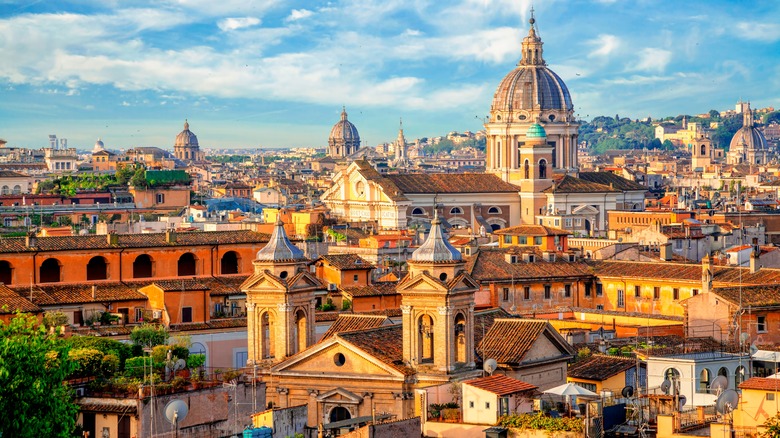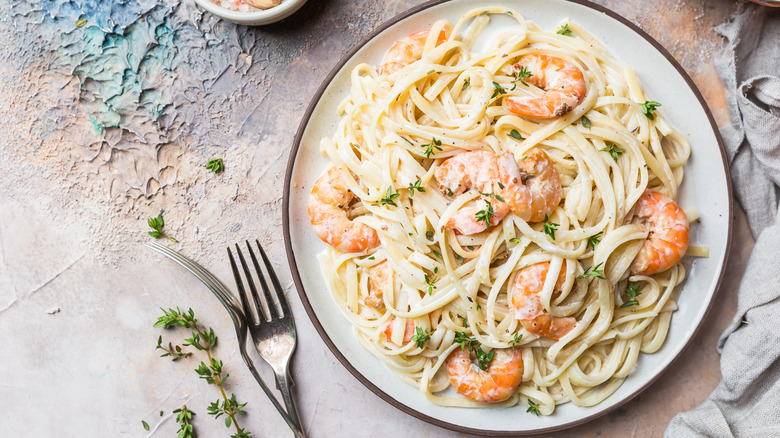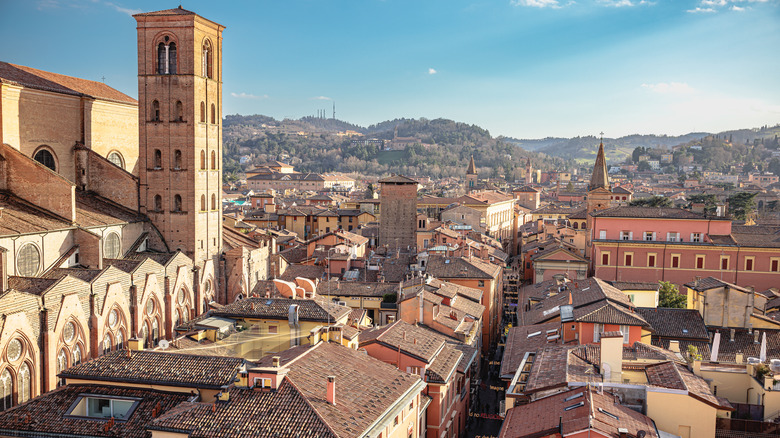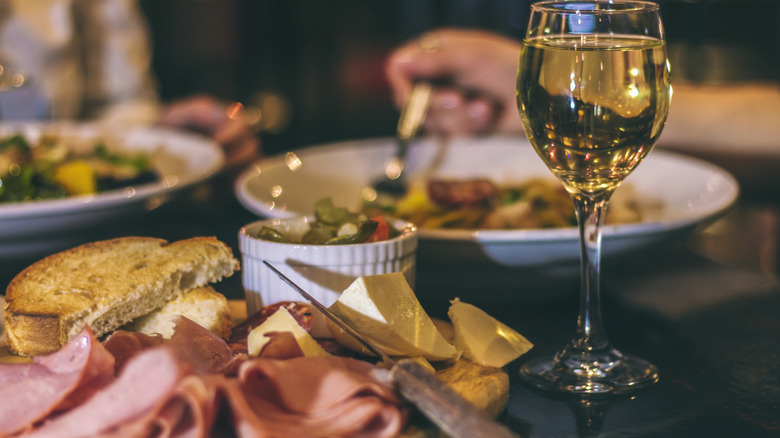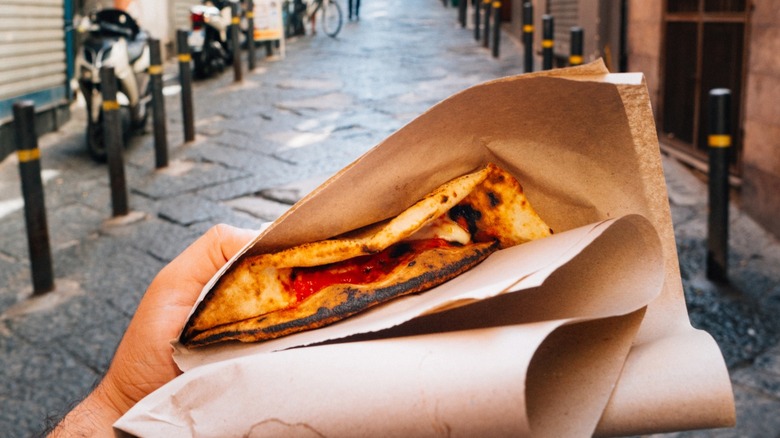The Most Common Myths About Italy You Need To Forget Before Your Trip
Travelers who want to visit Italy may dream of perusing famed Renaissance artworks or glimpsing the Colosseum. The iconic sights are some of the best in the world, and the food is second to none. Though, like any place you've never visited, you may have myths and misconceptions in mind about the lovely Italia. These rumors could compel even the well-traveled among us to stay away. Italy is one of the most expensive European countries to visit. So it's only fair that you know exactly what to expect before you go there.
Whether you hope to chow down on nothing but fettuccini alfredo all day or worry that you can't eat enough, these myths will all be dispelled. Then you can happily enjoy your Italian adventure or even live out those "Lizzie McGuire the Movie" dreams. After all, these scenes are what dreams are made of. And if you're in the early planning stages, consider this city the best place to kick off a vacation in Italy.
The food will resemble Italian-American dishes
If you plan to gallivant around Italy because you have a penchant for Olive Garden, you may want to rethink your trip. Sure, the food will be delicious, but it likely won't fully resemble how you imagine Italian food. Fettuccini alfredo? Never heard of him. Italian-American food is an amalgamation of cultures and traditions carried over by immigrants, though it isn't exactly Italian cuisine.
Food historian and James Beard-nominated cookbook author Francine Segan told the Huffington Post that Italian-American food arose from the desire to create new traditions. "It all started when the first Italian immigrants came to America and couldn't cook their favorite dishes because certain ingredients were either missing or simply didn't taste the same," Segan shared. "Italians who went into the restaurant business found that they could be more creative than they could in their homeland. Native Italians resist changes to their traditional dishes, but in America, those restrictions were lifted and chefs could flex their creative muscles."
Beyond the revelation that spaghetti and meatballs isn't an Italian staple, it's important to note that the country serves seasonal cuisine based on fresh ingredients. Traditional food also means something different in every part of Italy. So wherever you head, keep an open mind (and palate), and you may get home with a new favorite dish. And while you explore, avoid this costly tourist trap quality when picking a restaurant in Italy.
It's only worth visiting famous Italian cities
Just as France is more than Paris and the United States is more than New York City or Los Angeles, Italy is more than its heavy-hitting metropolises. It makes sense that destinations like Florence and Rome are a top priority for vacations to Italy; however, seeing more of the country will give you a lot more perspective. It has 20 regions, after all. One Italian region even offers whitewashed homes just like Santorini without the crowds and cost.
After a 25-day jaunt through Italy, Timothy Moore wrote for Business Insider that he'd spend more time in small towns than the famous cities if he did it again. "Some of our best memories were our days in Orvieto, Bracciano, and Civita di Bagnoregio, all charming towns between Rome and Florence," he expressed. "Wandering the streets, sampling the food, exploring a castle, and just observing the culture was so relaxing."
You don't need to skip the famous sights altogether. By all means, see the Duomo and Trevi Fountain. Instead, we want to bust the myth that other areas of Italy aren't worth seeing. You could go restaurant hopping in the foodie city of Bologna or embrace your culture vulture side in Turin. With so much to see, do, and eat, Italy has a whole world of possibilities to explore.
You have to eat a lot of courses at meals
For those familiar with Italian meals, you may know that they have the potential to span several courses. From a pre-meal aperitivo to the after-meal digestivo (and a bunch in between), you may worry that every time you eat, you'll go through a lot of food. Good news: It doesn't have to be that way. Although, yes, you will find multi-course meal options in Italy, you have other options for dining out.
"You never have to order a four-course meal in a restaurant," Elizabeth Minchilli, Rome resident and author of "Eating Rome: Living the Good Life in the Eternal City," told USA Today. "One course, plus a vegetable or antipasto, is just fine if that's what you want ... Italian waiters are generally very accommodating. There's no wrong way to order."
On top of ordering what you're comfortable eating, Minchilli also advises travelers to remember that portions are often smaller in Italy. She also suggests ordering a side of something if you want a little more food but don't want to risk getting too full.
All pizza is the same
Just as there are 20 regions in Italy with their own foods and cultures, there are also several kinds of pizza. While American pizza sometimes resembles its Italian cousins, these distinct types are all worth tasting. There's Pizza Napoletana, Pizza Siciliana, and Pizza Fritta, just to name a few. All are from different Italian regions with sometimes vastly different styles, flavors, and textures.
Giovanni Santarpia described to Food & Wine how something like a Neapolitan-style (or Napoletana) pizza made in his pizzeria is different for diners. "The sensations you get from eating a soft and well-leavened pizza are different," Santarpia told the outlet. "You feel all the flavors in one bite."
Those flavors are common in Italian pizza thanks to their (generally) more simple, fresh ingredients. Although the toppings offered on pizza in Italy tend to be fewer than their American counterparts, that doesn't stop travelers from reveling in the deliciousness. So don't let the differences scare you; give one or many of the Italian pizzas a try.
Italians are loud
It's a little ironic that one of the myths regarding Italians is that they are loud when Americans are notorious for being the loudest travelers. Contrary to what popular media may depict, Italians aren't really that booming of a bunch. Sure, they may get boisterous after a few glasses of wine, but who among us doesn't? This stereotype also doesn't account for the different regional cultures, in which case Northern Italians are known for being a bit more reserved.
In fact, you may not make many friends being loud in Italy, particularly in public. Though others have said that Italians may be a bit on the noisy side, so it could depend on individual experiences. While this might not be an irrefutable myth, it's still better to err on the side of caution when assuming anything about another culture. Keep your voice at a reasonable volume, especially if somewhere like a restaurant. Believe it or not, locals may judge you quietly (or not so quietly) if you make the place too loud to converse.
